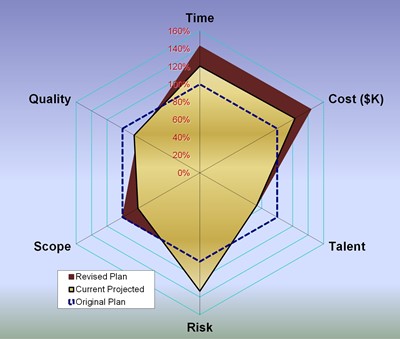SECOND EDITION
By Stacy Goff
Colorado, USA
Abstract
Governments and Enterprises alike continue to try to do more with less. As a result, Faster and Cheaper are increasingly attractive themes. But these themes can result in poor project performance if you have no agreement about your priorities. It is even worse if you have few Project Managers with the competences needed to achieve the results.
This article points out the flaws of mistakenly attempting to control project Gauges, and identifies the benefits of more effectively managing the project Levers, so project teams and organizations achieve their targets.
Prioritizing the Key Project Factors
 In our consulting practice, the first step we use in coaching the kick-off of large, complex projects, is to prioritize the project’s key dashboard factors. The factors consist of six “Vital Sign” measurements, related to project knowledge areas: Time, Cost, Scope, Quality, Risk, and the right Human Resources, or Talent. See them below.
In our consulting practice, the first step we use in coaching the kick-off of large, complex projects, is to prioritize the project’s key dashboard factors. The factors consist of six “Vital Sign” measurements, related to project knowledge areas: Time, Cost, Scope, Quality, Risk, and the right Human Resources, or Talent. See them below.
In our process, we engage stakeholders, including Sponsors, Steering Committees, Subject Area Experts, Managers, other team members, and also those who will be affected by the project’s results. Teams rank-order the priority of their top three factors.
Then during the project, we manage the project to optimize those three factors, while monitoring the status of all of them, typically using a project dashboard (as in the graphic at right). The result: Everyone is managing to the same success criteria.
Managing Faster and Cheaper
Given agreement about which Vital Signs are most important (and Time and Cost are often among them), we observe two different approaches Project Managers and their Managers use in managing them:
- Attempting to control Time and Cost—mere gauges—to assure you meet those targets.
- Managing key project levers—leading indicators—to achieve the desired Time and Cost outcomes.
The problem: too many of today’s Project Managers use only the first approach, managing gauges. The second approach, focusing first on Talent and Scope—the levers of success—then, monitoring the gauges—is far more effective.
To help audiences of all experience levels to better understand the difference between the two approaches, we use a few analogies. Those analogies include leading indicators vs. trailing indicators, front window vs. rear-view mirror monitoring, or managing inputs versus controlling outputs. The analogies are crystal clear for the majority of audiences, but not for all.
Introducing Levers and Gauges
Several decades ago, we began using this concept of Levers and Gauges as an additional way to illustrate the difference between the two approaches. Rather than giving you a dictionary definition of Lever and of Gauge, let us instead begin by providing some (non-project) examples.
Example 1. Setting: Dinner. The Levers are your fork and knife. What is the Gauge? Perhaps, how full you feel. Interestingly, for most of us, our Gauge has about a half-hour lag (except for chocolate, which never registers on our Gauges).
 Note that in this example, there are two Levers, and you must master the appropriate use of each. Note that appropriate varies with the continent.
Note that in this example, there are two Levers, and you must master the appropriate use of each. Note that appropriate varies with the continent.
Question 1: Is the Gauge important? Definitely! In fact, because of the lag in response, we need ways to determine the trend toward fullness if we are to be successful managing to it. Just-in-time reporting leads to over-eating!
Question 2: Can you avoid over-fullness by merely controlling the Gauge? No! You must manage your use of the Levers properly to do so. Already we can see useful comparisons to the project environment!
Example 2. Setting: The Shower.
In your shower, the Gauge is the hot/cold sensation when you test it with your hand. Other parts of your body may have different calibration for what temperature is “right”. This means that you adjust the readings of the Gauge, leaving a bit of tolerance for your safety.
What is the Lever? It is the faucet handle or handles. Note that single-Lever handles are easier to adjust.
But they are sometimes harder to figure out (a trade-off between ease-of-use and ease-of-learning).
More…
To read entire article, click here
Editor’s note: Second Editions are previously published papers that have continued relevance in today’s project management world, or which were originally published in conference proceedings or in a language other than English. Original publication acknowledged; authors retain copyright. This paper was originally published in 2005 on the IPMA-USA (ASAPM) website, and later on IPMA website in China, Ital and Russia. It is republished here with the permission of the author.
How to cite this paper: Goff, S. A. (2023, 2015, 2005). Project Levers and Gauges, PM World Journal, Vol. XII, Issue VIII, August. Available online at https://pmworldlibrary.net/wp-content/uploads/2023/08/pmwj132-Aug2023-Goff-Project-Levers-and-Gauges-2nd-edition.pdf
About the Author

Stacy Goff
Colorado, USA
![]()
STACY A. GOFF, the PM Performance Coach, has coached and inspired tens of thousands of project and program managers, and hundreds of organizations, on five continents, for over forty years. A Project Management practitioner since 1970 and consultant since 1982, he has also been a strong contributor to professional organizations such as IPMA® and PMI® since 1983.
He is a co-founder and past-president of IPMA-USA, and 2011-2014 Vice President of Marketing & Events for IPMA, the International Project Management Association. In September, 2015, he was named an IPMA Honorary Fellow.
Goff’s interest in project competence and performance began with establishing a PM Competency Center for a nuclear power plant in the early 1980s. It continued with international engagements during the 1980s and 90s as he helped organizations assess and improve their project and program performance.
Today, he coaches, speaks and performs keynote speeches at major project-related events. And, he continues to pursue his interest in individual, project team, organization, and national and international PM performance.
Stacy brings a results-oriented approach to Project Management coaching, consulting, and training. His insight for the needed PM Competences, and his delivery of effective training translate to improved project performance. In his working life, he combines his Project experience with sensitivity for the interpersonal skills areas—the human aspects of projects.
In his papers, presentations, workshops or in consulting, he combines his project experience with strategic linkage for all projects and programs. His insights and experience have provided competitive advantage for his clients for over 40 years. His business result: measurably increased PM Performance.
Contact Stacy by email: Stacy.Goff@gmail.com. His website is https://StacyGoff.com
All trademarks are the property of their registered owners.









